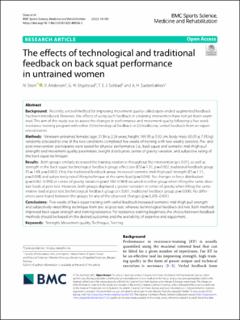| dc.contributor.author | Stien, Nicolay | |
| dc.contributor.author | Andersen, Vidar | |
| dc.contributor.author | Engelsrud, Gunn | |
| dc.contributor.author | Solstad, Tom Erik Jorung | |
| dc.contributor.author | Sæterbakken, Atle Hole | |
| dc.date.accessioned | 2023-03-01T10:55:50Z | |
| dc.date.available | 2023-03-01T10:55:50Z | |
| dc.date.created | 2022-09-02T09:52:27Z | |
| dc.date.issued | 2022 | |
| dc.identifier.citation | Stien, N., Andersen, V., Engelsrud, G. H., Solstad, T. E. J., & Saeterbakken, A. H. (2022). The effects of technological and traditional feedback on back squat performance in untrained women. BMC Sports Science, Medicine and Rehabilitation, 14(1):163. | en_US |
| dc.identifier.issn | 2052-1847 | |
| dc.identifier.uri | https://hdl.handle.net/11250/3054913 | |
| dc.description.abstract | Background
Recently, a novel method for improving movement quality called open-ended augmented feedback has been introduced. However, the effects of using such feedback in a training intervention have not yet been examined. The aim of this study was to assess the changes in performance and movement quality following a five-week resistance-training program with either (1) technological feedback or (2) traditional, verbal feedback from an experienced trainer.
Methods
Nineteen untrained females (age: 21.84 ± 2.24 years, height: 169.95 ± 5.92 cm, body mass: 65.05 ± 7.93 kg) randomly allocated to one of the two conditions completed five weeks of training with two weekly sessions. Pre- and post-intervention, participants were tested for physical performance (i.e., back squat and isometric mid-thigh pull strength) and movement quality parameters (weight distribution, center of gravity variation, and subjective rating of the back squat technique).
Results
Both groups similarly increased the training resistance throughout the intervention (p < 0.01), as well as strength in the back squat (technological feedback group: effect size (ES) = 1.31, p = 0.002; traditional feedback group: ES = 1.48, p = 0.002). Only the traditional feedback group increased isometric mid-thigh pull strength (ES = 1.11, p = 0.008) and subjectively rated lifting technique at the same load (p = 0.046). No changes in force distribution (p = 0.062–0.993) or center of gravity variation (p = 0.160–0.969) occurred in either group when lifting the same absolute loads at post-test. However, both groups displayed a greater variation in center of gravity when lifting the same relative load at post-test (technological feedback group: p < 0.001; traditional feedback group: p = 0.006). No differences were found between the groups for any of the observed changes (p = 0.205–0.401).
Conclusions
Five weeks of back-squat training with verbal feedback increased isometric mid-thigh pull strength and subjectively rated lifting technique from pre- to post-test, whereas technological feedback did not. Both methods improved back squat strength and training resistance. For resistance-training beginners, the choice between feedback methods should be based on the desired outcomes and the availability of expertise and equipment. | en_US |
| dc.language.iso | eng | en_US |
| dc.publisher | BMC | en_US |
| dc.rights | Navngivelse 4.0 Internasjonal | * |
| dc.rights.uri | http://creativecommons.org/licenses/by/4.0/deed.no | * |
| dc.title | The effects of technological and traditional feedback on back squat performance in untrained women | en_US |
| dc.type | Journal article | en_US |
| dc.type | Peer reviewed | en_US |
| dc.description.version | publishedVersion | en_US |
| dc.rights.holder | © The Author(s) 2022. | en_US |
| dc.source.volume | 14 | en_US |
| dc.source.journal | BMC sports science, medicine and rehabilitation | en_US |
| dc.source.issue | 1 | en_US |
| dc.identifier.doi | 10.1186/s13102-022-00556-5 | |
| dc.identifier.cristin | 2048168 | |
| dc.source.articlenumber | 163 | en_US |
| cristin.ispublished | true | |
| cristin.fulltext | original | |
| cristin.qualitycode | 1 | |

